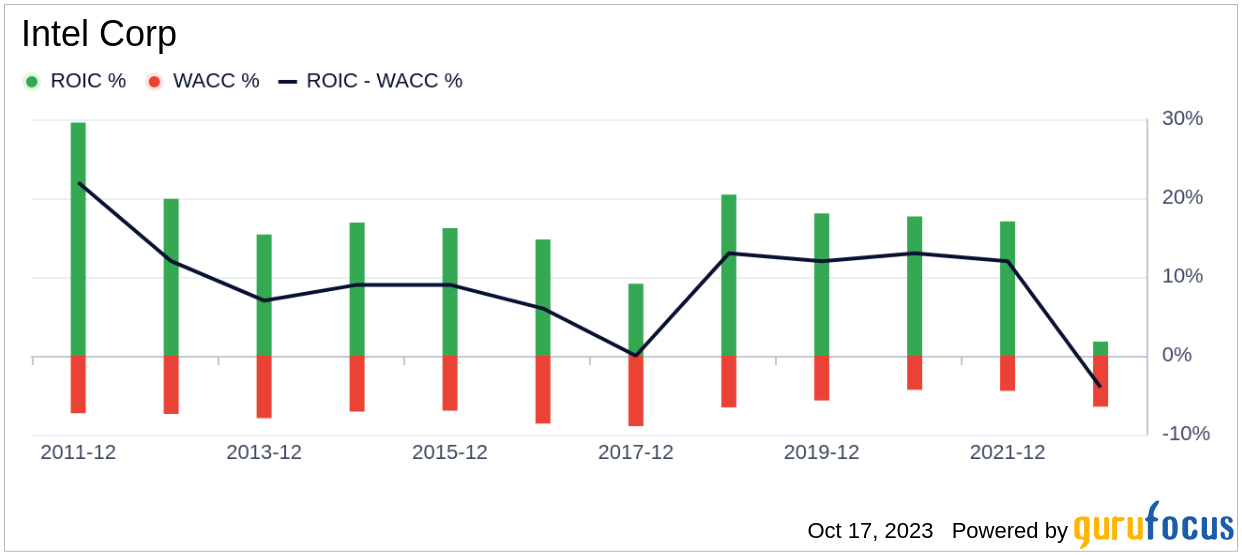Intel Corp (INTC, Financial) experienced a daily loss of -3.61% and a 3-month gain of 2.55%. With a Loss Per Share of 0.22, we aim to answer the question: Is Intel (INTC) modestly overvalued? In this article, we will delve into a comprehensive valuation analysis of the stock. Read on for a more profound exploration of Intel's value.
Company Introduction
Intel is a leading digital chipmaker, focused on the design and manufacturing of microprocessors for the global personal computer and data center markets. It pioneered the x86 architecture for microprocessors and was the prime proponent of Moore's law for advances in semiconductor manufacturing. Today, Intel remains the market share leader in central processing units in both the PC and server end markets. The company has also been expanding into new adjacencies, such as communications infrastructure, automotive, and the Internet of Things. Intel expects to leverage its chip manufacturing capabilities into an outsourced foundry model where it constructs chips for others.
Currently, Intel's stock price stands at $35.24, while its fair value (GF Value) is estimated at $31.76. This discrepancy suggests that Intel's stock may be modestly overvalued.
Understanding the GF Value
The GF Value represents the current intrinsic value of a stock derived from our exclusive method. This value is based on historical trading multiples, a GuruFocus adjustment factor based on the company's past returns and growth, and future estimates of the business performance. The GF Value Line on our summary page gives an overview of the fair value that the stock should ideally be traded at.
According to the GuruFocus Value calculation, Intel (INTC, Financial) appears to be modestly overvalued. At its current price of $35.24 per share and the market cap of $147.60 billion, Intel's stock seems to be modestly overvalued. This implies that the long-term return of its stock is likely to be lower than its business growth.
Link: These companies may deliver higher future returns at reduced risk.
Financial Strength
Investing in companies with low financial strength could result in permanent capital loss. Therefore, it is crucial to review a company's financial strength before deciding whether to buy shares. Intel's cash-to-debt ratio stands at 0.5, ranking worse than 78.52% of 903 companies in the Semiconductors industry. Based on this, GuruFocus ranks Intel's financial strength as 5 out of 10, suggesting a fair balance sheet.
Profitability and Growth
Investing in profitable companies, especially those demonstrating consistent profitability over the long term, poses less risk. Intel has been profitable for 10 out of the past 10 years. Over the past twelve months, the company had a revenue of $54 billion and a Loss Per Share of $0.22. Its operating margin is -4.44%, ranking worse than 75.34% of 953 companies in the Semiconductors industry. GuruFocus ranks the profitability of Intel at 8 out of 10, indicating strong profitability.
Growth is a crucial factor in the valuation of a company. The 3-year average annual revenue growth of Intel is -1.7%, ranking worse than 79.29% of 874 companies in the Semiconductors industry. The 3-year average EBITDA growth rate is -13.2%, ranking worse than 87.87% of 775 companies in the Semiconductors industry.
ROIC vs WACC
Comparing a company's return on invested capital (ROIC) to its weighted cost of capital (WACC) is another way to evaluate its profitability. ROIC measures how well a company generates cash flow relative to the capital it has invested in its business. WACC is the rate that a company is expected to pay on average to all its security holders to finance its assets. If the ROIC is higher than the WACC, it indicates that the company is creating value for shareholders. Over the past 12 months, Intel's ROIC was -0.55, while its WACC came in at 9.3.
Conclusion
Overall, Intel (INTC, Financial) stock appears to be modestly overvalued. The company's financial condition is fair, and its profitability is strong. Its growth ranks worse than 87.87% of 775 companies in the Semiconductors industry. To learn more about Intel stock, you can check out its 30-Year Financials here.
To find out the high-quality companies that may deliver above-average returns, please check out GuruFocus High Quality Low Capex Screener.
This article, generated by GuruFocus, is designed to provide general insights and is not tailored financial advice. Our commentary is rooted in historical data and analyst projections, utilizing an impartial methodology, and is not intended to serve as specific investment guidance. It does not formulate a recommendation to purchase or divest any stock and does not consider individual investment objectives or financial circumstances. Our objective is to deliver long-term, fundamental data-driven analysis. Be aware that our analysis might not incorporate the most recent, price-sensitive company announcements or qualitative information. GuruFocus holds no position in the stocks mentioned herein.




